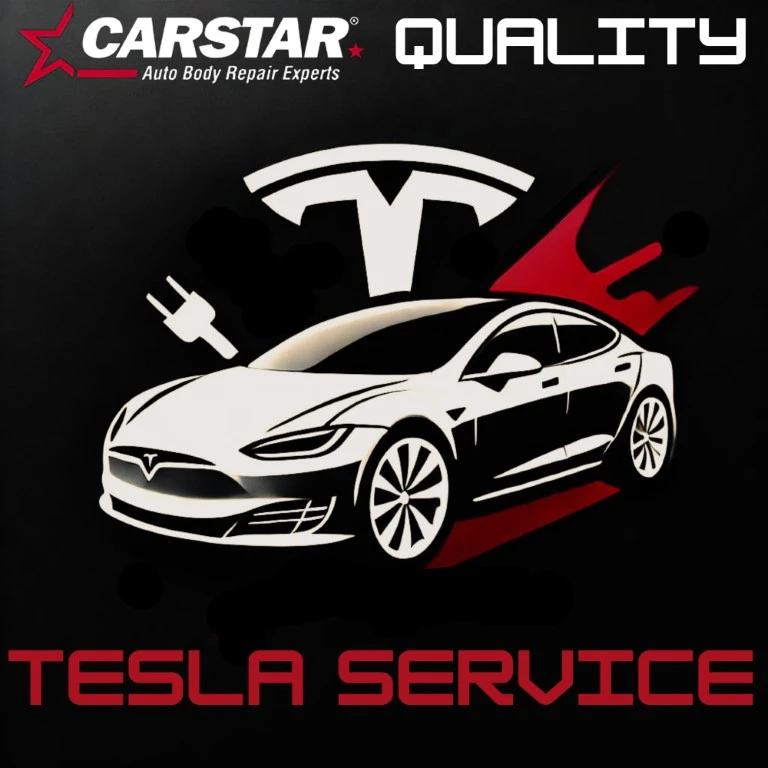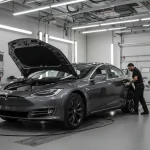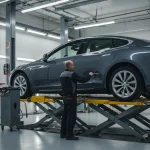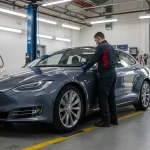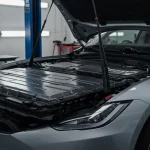Navigating the world of car repairs can often feel daunting, especially when you’re dealing with a cutting-edge electric vehicle like a Tesla. You might be wondering if it’s even possible to repair Tesla body panels or where to turn for reliable service. Rest assured, both Quality Tesla Service and Carstar Quality Auto Body & Service offer expert care tailored to meet the unique needs of Tesla vehicles. From employing certified technicians equipped with state-of-the-art tools to using genuine Tesla parts, these centers ensure that your car remains in top-notch condition. Whether you’re in need of minor adjustments or significant collision restoration, these trusted service providers stand ready to offer a seamless repair experience, backed by a commitment to excellence and customer satisfaction. With convenient service hours, online booking, and hassle-free insurance coordination, getting your Tesla back in pristine condition has never been easier.
Understanding Tesla Body Construction
Tesla vehicles are renowned for their cutting-edge technology, not just in terms of their electric powertrains but also regarding their body construction. Understanding the foundation of what makes these vehicles unique is the first step in appreciating the nuances of repairing them.
Materials used in Tesla body panels
Tesla utilizes a blend of materials for its body panels, primarily focusing on aluminum and steel. Aluminum is favored for its lightweight properties, which contribute to the car’s efficiency and performance. However, steel is also strategically used in areas requiring extra strength and rigidity, balancing the vehicle’s overall integrity and safety.
Unique characteristics of Tesla’s design
The design of a Tesla is not just about aesthetics but also about functionality and performance. One distinctive feature is the smooth underbody, which enhances aerodynamics, reducing drag and thus improving range. The frame’s construction prioritizes energy absorption pathways, crucial for safety in case of a collision, showcasing Tesla’s dedication to marrying form with function.
Comparing Tesla body construction to traditional vehicles
Compared to traditional vehicles, which predominantly use steel, Tesla’s use of aluminum is a game-changer. Aluminum is more challenging to work with, requiring specialized repair techniques and tools. Additionally, the integrated nature of Tesla’s design, including how parts are assembled and the incorporation of technology, sets it apart from conventional vehicles and impacts repair processes.
Tesla Body Panel Damage: Common Causes
Even with advanced construction, Tesla body panels are not immune to damage. Understanding common causes can help in preemptively addressing some risks.
Collision impacts
Collisions are a typical source of damage, ranging from minor scratches and dents to significant structural harm. The extent depends on the impact’s severity and the collision angle.
Natural wear and tear
Over time, Tesla body panels may show signs of wear from regular use. This includes minor dents, scratches from road debris, and fading from sun exposure.
Environmental factors
Extreme weather conditions, including hail, can cause damage. Salt used on roads during winter can also lead to corrosion if not properly managed.
Initial Assessment of Damage
When damage occurs, the initial assessment is crucial in determining the best course of action for repairs.
Visual inspection techniques
A thorough visual inspection can reveal the extent of surface damage. Looking for alignment issues, gaps in panels, or inconsistencies in paint can indicate underlying problems.
Using technology for damage assessment
Advanced diagnostic tools and software are essential, especially for Tesla vehicles which integrate technology in their construction. These tools can help assess the electrical systems and detect issues not immediately visible.
Determining repairability
Assessing whether a panel can be repaired or needs to be replaced depends on several factors, including the damage extent, the specific panel’s material, and how the damage affects the vehicle’s structural integrity.
Repair Vs. Replacement
Deciding whether to repair or replace a damaged body panel involves various considerations.
Factors influencing repair or replacement decisions
The decision usually hinges on the cost, the extent of the damage, and how either option impacts the vehicle’s safety and value. Sometimes, repairing might compromise the car’s structural integrity.
Cost implications
Typically, repairs are less expensive than replacements. However, for Tesla vehicles, the high cost of parts and the need for specialized labor can make both options pricey.
Long-term considerations for vehicle integrity
Choosing between repair and replacement also involves considering how each option affects the vehicle’s long-term performance and safety. Ensuring the vehicle remains safe is paramount.
Repair Techniques for Tesla Body Panels
Tesla’s unique construction requires equally specialized repair techniques.
Traditional body repair methods
While some traditional repair methods apply, such as dent removal and repainting, the specifics can vary significantly due to the materials Tesla uses.
Advanced repair techniques specific to Tesla
Techniques like aluminum welding and bonding require specialized equipment and expertise. Repair centers need to be certified and trained in dealing with high-voltage systems to ensure safety.
Safety precautions during repairs
Given the electrical nature of Tesla vehicles, safety is a major concern. Repair technicians must follow stringent safety protocols, especially when working near the battery and electrical system.
Specific Challenges in Repairing Tesla Body Panels
Several challenges are unique to repairing Tesla vehicles.
Aluminum repair complexities
Aluminum, while advantageous for its lightweight and strength, is more difficult to repair than steel. It requires different tools and techniques, and improper handling can lead to further damage.
Integration with vehicle’s electrical system
Tesla’s design integrates the body and electrical systems closely, making repairs more complex. Care must be taken to avoid damaging the electrical components.
Ensuring structural integrity post-repair
Maintaining the vehicle’s structural integrity, especially after significant repairs, is crucial for safety. This requires precise work and adherence to Tesla’s repair specifications.
DIY Vs. Professional Repair
The complexity of Tesla vehicles generally makes professional repair the safer option.
Understanding the risks of DIY repair
Attempting DIY repairs on a Tesla can risk personal safety and potentially void warranties. The specialized nature of these vehicles means even simple tasks may have complexities not apparent to the untrained eye.
Benefits of professional repair services
Professional services have the necessary certification, tools, and expertise to conduct repairs safely and effectively, ensuring the vehicle’s integrity and value.
How to choose a repair provider
Selecting the right provider involves checking for certifications, experience with Tesla vehicles, and a track record of quality work.
Selecting the Right Service Provider
Choosing a repair shop for a Tesla requires careful consideration.
Certifications to look for in a repair shop
Certifications from Tesla or recognized automotive bodies indicate a shop’s capability to perform high-quality repairs on these vehicles.
Experience with Tesla vehicles specifically
A service provider with specific experience in Tesla vehicles will be familiar with their unique repair needs and challenges.
Questions to ask potential repair providers
Inquire about their experience, certifications, warranty on repairs, and whether they use genuine Tesla parts, which can impact the car’s functionality and resale value.
Cost of Repairing Tesla Body Panels
Repair costs for Tesla vehicles can vary widely based on the damage extent and the chosen repair shop.
Average repair costs compared to other vehicles
Tesla repairs can be more expensive due to the specialized techniques and parts required. However, these costs are somewhat offset by savings in fuel and lower maintenance requirements over time.
Insurance considerations
Vehicle insurance policies may cover repair costs, but it’s crucial to understand your coverage, especially for electric vehicles, as policies can differ.
Minimizing repair costs without compromising quality
Choosing a certified repair shop with experience in Teslas can ensure repairs are done right the first time, preventing further expenses from corrective work.
Future of Tesla Repairs
As Tesla continues to innovate, the repair industry must adapt.
Impact of evolving Tesla designs on repair processes
New models and design updates can introduce new repair challenges, requiring continuous learning and adaptation by repair technicians.
Technological advancements in repair methodology
Advancements in repair technology, such as sophisticated diagnostic tools, will play a crucial role in efficiently and effectively servicing Tesla vehicles.
Training and resources for repair technicians
Ongoing training and access to the latest repair resources are vital to keeping up with Tesla’s technological advancements, ensuring technicians can continue to provide high-quality service.
